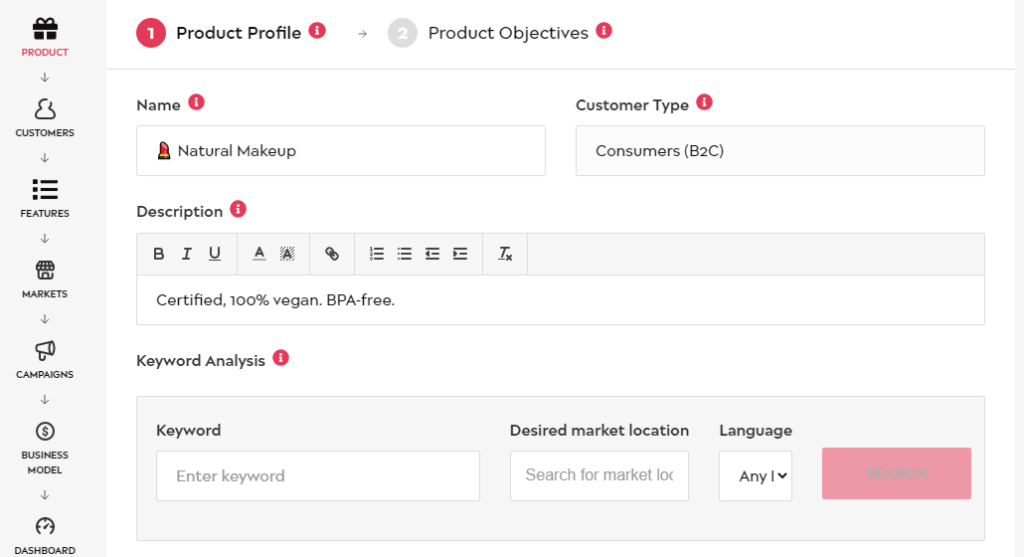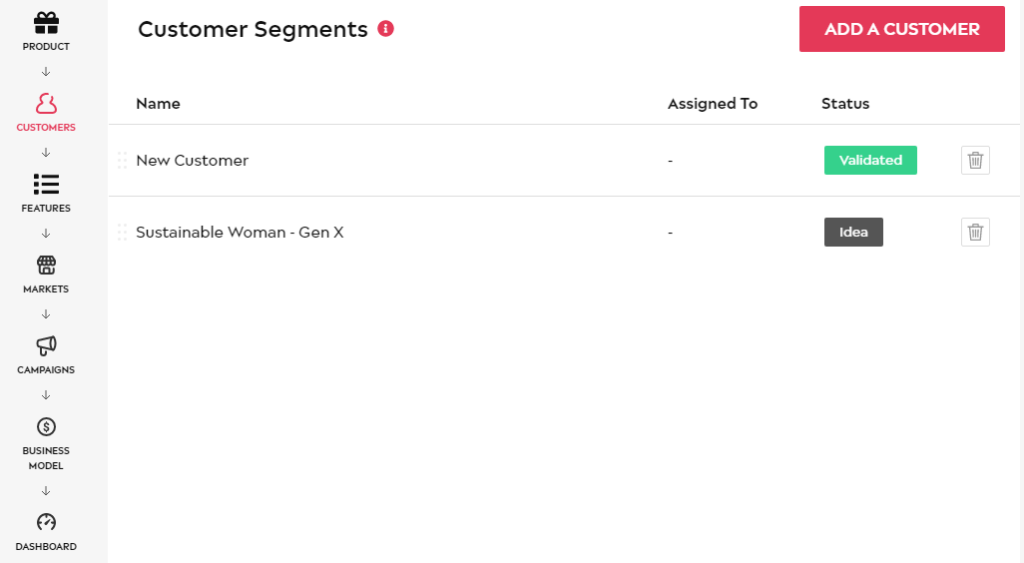When growing your fashion eCommerce brand or launching a new product line, take a moment and consider your goal.
Do you want to make money? Are you aiming to disrupt the market and bring customers a new line of products unlike any they’ve seen before?
Or is your goal to address your target customers’ pain points?

All three objectives may be driving your entrepreneurship. But the latter is the most important—and it’s easy to lose sight of that when you’re focused on the minutiae of getting your new project off the ground.
Yet, addressing customer pain points should be at the core of your entire eCommerce fashion brand. Understanding your ideal buyers’ needs and desires is paramount to bring them the products you know they want or need instead of what you assume they’ll buy.
That’s where extensive research in the planning stages of launching your new product comes into play. You can appeal to the right customers with the right products and generate revenue based on solid insights.
A key part of building sustainable revenue is increasing the average order value of your products, and the Jobs-to-be-Done (JTBD) framework assists in doing that.
So, to help you get your fashion eCommerce product line off to a great start, we’ve created the following guide. It covers everything you need to know about the Jobs-To-Be-Done theory framework, how you can use it to increase average order value, and more.
What is the Jobs-to-Be-Done Theory Framework, and How Does It Relate to Fashion?

Let’s say you visit your favorite department store to shop for a new shirt or dress. You find an item that looks fantastic on the rack, and you feel pretty sure it’ll work just as well (if not better) on you when you try it in the changing rooms. And, thankfully, it does.
So, you hand your money over and walk away with a killer new piece ideal for a date night or a catch-up with friends.
What do you think is the most important part of buying that shirt or dress?
- Is it because you like the color or patterns?
- Is it down to the material and fit?
- Or is it because the shirt or dress makes you feel more confident about your appearance?
In other words, while you’re trying the garment on, you are assessing which one of your needs, or pain, as it’s commonly known in marketing, it fulfills and to what extent it solves it.
It’s highly likely to be the piece’s confidence-boosting power than its design, material, or fit. But let’s be clear: those factors still all play a critical role in the shirt or dress’s ability to make you feel better about yourself.
That’s how the JTBD framework works: It encourages you to focus on the job that a customer essentially hires a product to do and helps them achieve that desired outcome.
In a way, therefore, you’re hiring that gorgeous new shirt or dress to perform the job of making you look and feel better about yourself when you’re with friends, family, or trying to impress the special one.
Similarly, customers aren’t just buying your goods, apparel or not. Instead, they are hiring them to fulfill a role. On top of this, customer jobs with severe pain present the product as a solution, which, in turn, you sell to your customers for a profit.
Note that customer jobs show:
- Why do customers buy your product
- How do they buy it
- And how they end up using it
This information is indispensable in successfully sourcing products like apparel since you can pretty much define your target audience. Additionally, before skyrocketing your clothing brand, you also need to understand the two basic types of customers’ jobs:
- Functional
- Emotional
But more on that a bit later.
Assessing the Criteria that Makes a Product Right for the Job to Be Done
Back to the shirt, now. So, the shirt or dress can do its job well because it has the right combination of factors, just as the right candidate for a role within an organization does:
- It fits well;
- The fabric feels good against your skin;
- It’s easy to put on and take off;
- It compliments your shoes;
- The cost is within your price range;
The JTBD framework encourages companies to remember that while a customer pays money for a well-made garment with eye-catching colors and a tailored fit, what they’re really buying is the experience of feeling good with the attire on their body.
For this reason, you also see Jobs-to-be-Done theory referred to as outcome-driven innovation: You’re concentrating on what outcome a customer wants to achieve when they invest in a specific product.
And keep in mind that the job outcome can be more nuanced in some cases than in others. For instance, you buy a shirt because it looks good with a pair of jeans and loafers. But you choose the dress because it accentuates your hourglass figure, matches the shawl you want to wear, and it has pockets to store your credit card, so you don’t need to carry your purse all evening.
Your pain point would be that you don’t currently own a shirt or dress that meets the necessary criteria, and your current wardrobe can’t supply you with a piece that’ll give you the confidence boost you need.
Understanding your target customer’s pain points will help you determine the necessary boxes your clothing should tick for the job to be done.
Main Jobs Versus Related Jobs
The Jobs-to-be-Done framework separates a customer’s goals when purchasing a product into Main Jobs and Related Jobs. You can deliver valuable products that satisfy buyers by addressing both job types.
To continue our shirt-and-dress example, let’s consider the Main and Related Jobs both garments need to do successfully.
Take a look at this graphic from UX Design Collective:

- Main Jobs: Make you look good and feel confident;
- Related Jobs: Fit comfortably, complement your shoes, and match the dress code of a restaurant or other venue.
We can separate these further into different sections for both job types:
- Functional Aspects: A customer’s practical, objective requirements (fit, ease of putting on and taking off);
- Emotional Aspects: A customer’s subjective requirements (how the garment inspires confidence and helps hide your holiday weight).
And we can separate Emotional Aspects into:
- Personal Dimension: How the customer feels about the product (the shirt or dress makes you feel confident);
- Social Dimension: How the customer believes they’re viewed while using the product (you see other diners admiring your outfit, so you feel attractive and more confident);
Breaking down customers’ jobs with this framework is vital for creating products that serve buyer needs and gaining a competitive edge in your market. You can apply this to clothing products, no matter what your niche or audience.
How Does Jobs-to-Be-Done Affect Consumers’ Average Order Value?

Increasing average order value (AOV) enables you to generate higher income by encouraging customers to buy more each time they visit your fashion eCommerce site with the intent to purchase.
How do you do this?
You can increase AOV by building a concrete understanding of the jobs your customers want to hire your products to perform based on their functional and emotional requirements. You’ll then be able to identify valuable opportunities to grow average order values via multiple techniques, such as:
- Upselling
- Cross-selling
- Purchase experience personalization
What Is Upselling?

Businesses leverage upselling to encourage customers to buy a more expensive or premium version of a product, or add-ons, that lead to a more profitable sale. A premium item could be a newer, more advanced release of a popular item.
For example, you could offer a best-selling T-shirt made from sustainably sourced organic materials at a higher price point than the older, cheaper, fast-fashion version.
So in this particular case, making consumers feel confident about their purchase, as well as comfy, you address both the Main and Related Jobs concepts. At the same time, by presenting them with a framework of environmentally friendly materials, you invest in Social Dimension. As customers believe they’re viewed in a positive light when wearing your organic clothes, the upselling of additional products becomes easier.
What Is Cross-Selling?

Cross-selling involves presenting customers with products that complement or enhance the main item they want to buy. This can prompt them to add extra goods to their cart and generate additional income for your fashion eCommerce business.
For example, a customer who wants to buy a beautiful bodycon dress that flatters their figure might invest in a bag and a pair of shoes (or other accessories) in a matching color or style.
With the JTBD framework in mind, during cross-selling, you’re trying to address both the Main and Related Jobs, as well as the Functional Aspects concept.
To make this easier to understand: According to the Functional Aspects job type section, customers are satisfied when a product meets their practical, objective requirements. Imagine now how great they must feel when they find that they can supplement their original purchase with extra helpful items to complete their look. So, that’s what cross-selling comes in and how it connects to Customer Jobs. It offers customers additional, but relevant to the original purchase, high-quality products.
What Is Purchase Experience Personalization?

Personalizing the purchase experience enables you to present customers with products they’re likely to buy based on their:
- Purchase history
- Behavior
- Personal data
- Demographic factors (e.g., age, location)
Personalization is a must: more than 70% of consumers find impersonal shopping experiences frustrating, and over 35% feel businesses should do more to provide better personalization.
What is more, personalization is excellent to increase revenue and explore and identify consumer behavior. In fact, by categorizing your customers according to the metrics above, you can understand your consumer base and adjust your products to match their expectations and personality. In other words, with personalization, you determine what products sell more so that you can adjust your inventory accordingly.
For instance, by analyzing consumer purchase history and behavior, you can effectively address the Main and Related Jobs concepts. On top of this, you can ascertain the Emotional Aspects, how consumers gain confidence from the product (Personal Dimension) or if they believe products make them more attractive to the eyes of third parties (Social Dimension).
In every case, upselling, cross-selling, and personalization can help you increase the average order value for your fashion eCommerce business. So, using the Jobs-to-be-Done theory framework enables you to identify ways to upsell, cross-sell, and personalize to empower customers to meet their needs with the right job-specific products.
Applying the Jobs-to-Be-Done Theory Framework to a Successful Brand
Online footwear and clothing retailer Zappos makes a fantastic example of a brand that understands its customers’ needs and its products’ jobs.
According to a Harvard Business Review article, Zappos founder Tony Hsieh discussed how his business combines free shipping to customers in the United States with an innovative returns policy.
Essentially, Zappos has built its shipping and returns process to deliver a unique service: it allows buyers to return goods at any time within 365 days of their purchase if they’re not completely satisfied with them for any reason.
And here’s the icing on the cake: Zappos offers free shipping both ways, meaning that customers receive their products in the mail at no cost, with no minimum order value, and they can send them back within one year if they’re unhappy with said purchases for free.
In his Harvard Business Review piece, the author describes the additional shipping costs as considerable and calls them a marketing expense. He says that many customers order five pairs of shoes and return those that don’t fit right or don’t like but keep those they do like.
In fact, the author considers this worthwhile because he’s learned that customers will buy more and be happier in the long run if we can remove most of the risk from shopping at Zappos.
That’s an essential factor to consider: Risk. Providing customers with the means to buy any items they like and send them back with a broad returns window enables them to reduce their danger of wasting money on goods that don’t serve their purpose.
For example, a consumer might buy two pairs of shoes to match their suit for meetings at the office. One pair is too light for the buyer’s favorite grey suit, but the other is perfect. They return the former and keep the latter. Zappos covers the cost of shipping and loses the profit from one pair.
But it has provided the customer with a product that does its job and delivered quality service—both of which could be enough to bring the customer back in the future.
Zappos has paid attention to its customers’ shopping habits and needs and found a way to provide a service that caters to both.
How Can You Use the Jobs-to-Be-Done Framework for Your Fashion eCommerce Business?
Now that we’ve learned about the Jobs-to-be-Done framework, let’s explore how you can use it for your fashion eCommerce business.
Determine the Jobs Your Products Need to Do Based on In-Depth Research

You can only create products that serve your target customers’ jobs by researching them in detail.
You might base your product development and operations on assumptions. For example, you may know that you want to target women aged 18-35 with your fashion but don’t know what shoppers in that demographic actually want. And that could cause you to miss the mark—and the potential revenue on offer.
Instead, you would benefit more by interacting with the type of women you want to market your products to through various research methods.
Revlon researched and developed its Vital Radiance products over two years. They made crucial discoveries about women in their target demographic (50+ years of age) during this time. For example, they found that the women were struggling to find a foundation that wasn’t too dry or that eye shadow was difficult to apply to wrinkled eyelids.
This research enabled them to identify how current products on the market failed to do the jobs customers needed them to and offer an innovative solution.
You can research your target audience via:
- Online surveys
- One-to-one interviews
- Focus groups
- User testing
- Field research
- Market research reports (available online)
- Studying beauty trends
Gathering data from multiple sources will equip you with the consumer insights to innovate products (or work with the right suppliers) and deliver where others don’t.
Build Segmentation Around the Jobs and Outcomes
Defining customer segments that fit your fashion products (and around the jobs and outcomes) is a fantastic way to increase conversions.
In fact:
By targeting your marketing communication to the customer segments, you’re guaranteed sales growth.
But, what exactly is customer segmentation?
Simply put, customer segmentation is the process of dividing customers into different groups based on common characteristics. By doing so, you enable your fashion eCommerce business to:
- Source or develop the right apparel;
- Estimate market size;
- Get a competitive edge;
- Market the apparel to the customer segment efficiently and profitably.
Apart from the above benefits, which are the most obvious ones, customer segmentation offers:
- Increased competitiveness
- Greater strategy
- Better allocation of resources
- Growth in a profitably way
- Fine-tuned and personalized buyer’s journey
- Price optimization
In order to skyrocket your fashion brand, customer segmentation requires specific data about potential customers and analysis to identify the patterns that can be turned into segments. As such, customer segmentation is unlikely without customer feedback. To sum up, the more detailed your understanding of your target audience, the better your sales will be.
Remember: Each customer segment has particular problems and unique solutions. Stay focused on one segment only, such as the age group 24-35, to not get overwhelmed.
How to Segment Customers in a B2C Fashion Firm?
As a fashion eCommerce brand, you’re probably a business-to-consumer (B2C) company. If so, you have to segment customers according to demographics, such as age, gender, and marital status.
For example:
Fashion businesses segment customers by age and gender. Clothing retailers, after identifying the unique needs of each age group, source relevant clothing products. As a general rule, younger audiences are into different apparel and brands than older customers. Similarly, mature customers access other marketing channels than a younger consumer base.
Think of it like this: You could segment some customers who want to keep their lips moisturized all day with an all-natural product and others who wish to convey their professionalism through a well-crafted suit. In this way, you know what to sell and to whom.
Occasionally, fashion companies segment customers based on their shopping behavior. This is known as RMA (Recency, Monetary, Frequency) based segmentation. An RFM analysis classifies customers into different categories based on how recently they purchased, how frequently they purchase new products, and how much they spend on clothes, which is exceptionally data to understand your target audience.
Undoubtedly, therefore, segmentation is fundamental when launching a fashion line. Without it, you don’t know who your customers are nor what they want to buy.
Embed the Jobs-to-Be-Done at the Heart of Your Fashion eCommerce Company

Base your products around helping customers with products that fulfil the required jobs, drawing on your market research. Make this job (or jobs) the focus of your enterprise, so it informs everything you do.
Providing buyers with goods that address their pain points and fulfilling Main and Related jobs can be part of your marketing, customer service, and aftercare. Over time, keep asking if the products you offer are the best solution for those jobs—and find new ones if your answer is no.
Invest in Jobs-to-Be-Done to Maximize Relevance
Carefully consider the job to be done when devising new products or expanding your clothing brand. You may feel tempted to conceptualize and develop items purely to appeal to a current, fleeting trend or even to court controversy.
Both may help you attract attention and gain publicity—but will they enable your customers to do the jobs at hand (e.g., impressing potential employers during an interview, reducing foot pain on a long hike)?
If the answer is no, those new products or business expansions could take you in the wrong direction. Invest in initiatives that increase your brand’s relevance and value to your target customers, rather than leaping at short-term opportunities that offer little ROI.
How to Identify Customer Jobs-to-Be-Done Easily
Ready to identify the job to be done and determine how you can address customer pain points?
Incorporating the JTBD framework into your operations is simpler than ever, thanks to online tools designed to help you run a successful eCommerce business. EpiProdux is an innovative platform that provides you with various tools powering market research and validation, product features, marketing campaigns, business model validation, and more.
You can use EpiProdux to understand customer jobs better and work out how your products help them achieve the necessary outcome. Here’s how:
Start by choosing the product from your Portfolio. You may have multiple projects running at one time.

Next, you’ll find yourself in the Product Profile section. This space is dedicated to keyword analysis, market hypothesis, and the problems your product solves. But you can move on jobs-to-be-done by clicking on the Customers icon on the left-hand side of the screen.

Choose the relevant Customer Segment from the list. The Status may show that the segment is Validated or an Idea at present.
After this, you’ll be greeted by more information on the selected Customer Segment in the Details section. However, you can click on the Customer Jobs section to begin your analysis of the job to be done.

Now, you can fill in the fields on the Customer Job page one step at a time:
Job Name
Describe the customer job to be done: What outcome do they want to achieve through a specific clothing product?
Job Importance
Assess how important the job is to your customer compared to other jobs, based on an importance scale:
- Very low: Failing to do the job has no impact on the customer
- Low: Failing to do the job has a negligible effect on the customer
- Medium: Failing to do the job annoys the customer
- High: Failing to do this important everyday job impacts multiple activities
Very High: Failing to do this critical job leads to severe consequences
Job Frequency
Work out how frequently a customer has to do an important job, daily, weekly, or monthly.
You stand to generate more revenue if your product does a regular job than a less frequent job. Your customers will depend on it, and your company, more over time.
Pain Description
Pinpoint severe pains that frustrate your customers before, during, and after trying to get a job done. These may include functional, social, and emotional pains.
For example, a mother who can’t find suitable sustainable clothing for their children may feel angry at the lack of options and experience guilt over how her purchase decisions affect the planet.
Pain Level
Determine the level of pain customer experiences when doing the relevant job, from Mild to Severe, with the pain scale.
Severe pain points mean that the customers cannot get a job done because they lack a solution. That’s where your product can change and improve their lives.
To better understand the significance of the pain level, its relation to customer jobs, and how it eventually drives sales, you must consider that the more severe the pain of a customer, the better your solution (e.g., products) should be.
In actuality, to succeed as a fashion brand and survive amidst the big names, you have to find customer jobs with severe pain. Through your products, aim to describe a severe pain before, while, and after finding the solution. By doing so, customers will keep coming back to cure their pain, generating revenue.
As you constantly remember that your product features alleviate your customer paints, strive to assess the pain level of your customers to get a better feeling of them and what they want to come up with a more targeted and effective solution:
- Mild: I’m aware of my pain only when I pay attention to it.
- Tolerable: I’m continuously aware of my pain.
- Distressing: I think about my pain most of the time.
- Intense: To do important daily activities is difficult.
- Severe: To do important daily activities is not possible.
Score
This expresses the customer’s opinion, feeling, or attitude as a numerical value.
The higher the customer’s pain on the pain scale is, the greater their disappointment regarding your eCommerce services or the quality of your products. Consequently, strive to offer an exceptional customer service experience to keep consumers happy on the lower end of the scale.
Suffice to say, but without a pain scale, you cannot determine the satisfaction or dissatisfaction of your customers. And suppose you cannot find out how your consumers feel. In that case, you cannot adjust your Main and Related Jobs concepts accordingly to personalize your products, increase customer experience, and skyrocket sales.
Magnitude
This shows the overall emotional strength of the pain description, and more substantial customer pain can lead to a more profitable acquisition.
Complete this section to gain a clearer insight into the customer’s job to be done, the severity of their pain points, and how valuable your fashion products are to your target audience.
Conclusion
The Jobs-to-be-Done framework is a fantastic way to scale a fashion eCommerce business that delivers products that can genuinely benefit your target customers.
You’ll provide buyers with goods that enable them to achieve a specific outcome at a functional and emotional level, such as finding a shade of lipstick that suits their complexion best and helps them feel empowered when they step into the boardroom for a crucial weekly meeting.
Use EpiProdux to enhance your understanding of a customer’s job’s to be done and make informed decisions that help you increase revenue.
On that note, use EpiProdux to set objectives and goals, create and execute marketing campaigns, and simplify customer and market segmentation, something that competitors don’t do. You can also assess pain levels, and analyze your target audience to know what solution to sell and to whom and how to convert one-time prospects to repeaters.
Besides, with EpiProdux, strategic customer jobs stay in one place, conveniently helping you make even more sales as you address the entire customer journey with the JTBD framework in mind. In this way, you avoid making costly mistakes by developing products consumers love and purchase.


